New methods of growing potatoes help to get an excellent potato crop, even on heavy soils. The use of small-scale mechanization means: small-sized motoblocks with mounted plows, harrows, and hills facilitate the hard work of potato growers at times. Effective organic and chemical products protect potato plantations from pests and diseases.
Content
Potato Growing Methods
Gardeners who are familiar with the difficulty of growing potato crops are constantly inventing methods that would reduce physical effort, but not to the detriment of the crop. They master the existing methods, empirically identify their advantages and disadvantages.
Traditional growing method
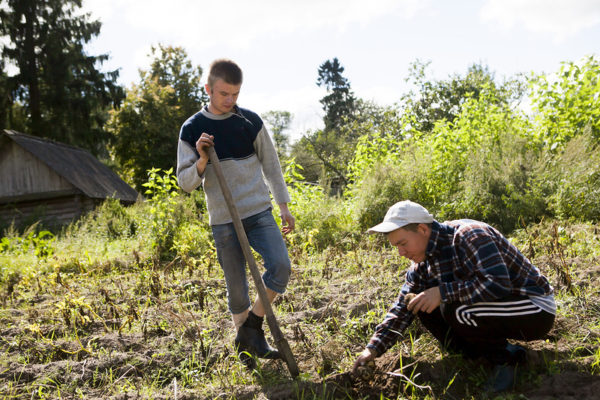
This simple method of growing potatoes has been developed by many gardeners. In Russia, it has become a tradition. The young generation of gardeners adopts experience from grandfathers and grandmothers, learns from them the secrets of agricultural technology of potato cultivation.
Description of technology:
- A piece of land is dug manually or with a tractor (if the area is large), harrowed with a rake or cultivator. Manure and mineral fertilizers are laid out on the surface of the earth.
- Determine the method of landing: a smooth landing, in a trench, or on a ridge. It depends on the structure of the soil and the location of the site. Ridge planting is advisable on heavy soils with a high occurrence of groundwater. The distance between the ridges should be about 0.7 m, and their height is 15-20 cm. Potatoes are planted in the trench if the soil is light (sandy) so that the moisture is held longer near the tubers and does not evaporate. Smooth landing is chosen for flat areas with soil, which passes moisture and air (chernozem) well.
- Outline the direction of the rows. They should be located from south to north so that the whole field is well lit by the sun.
- With a shovel, dig holes or trenches in the selected direction. Onions can be added to each seat onions (or other remedies for the Colorado potato beetle). Seed tubers are placed in pits or trenches at a distance of 30-40 cm, buried with earth.
- The first time they spud potatoes after growing 5-6 leaves. The height of the potato bush is not more than 15 cm.
Further care for potatoes after planting is earthing up, weeding is carried out as potato bushes and weeds grow, 1-2 times a month.
Pros:
- the traditional method does not require special conditions for soil preparation;
- a simple potato growing technology is available for beginner potato growers;
- in order to grow potatoes, no additional materials are needed for arranging the beds (boards, barrels, bags).
Minuses:
- in a small area of suburban areas it is impossible to get a big crop;
- the area reserved for growing potatoes takes up a lot of space;
- Colorado potato beetle can go to other crops planted near potato beds.
Summer residents who own small plots are engaged in the cultivation of early potatoes, and they buy potato stocks for the winter in markets or in stores.
Dutch way
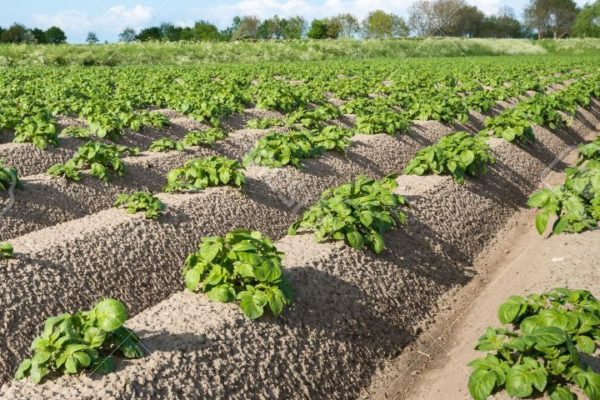
In Holland (Netherlands), a warm and mild climate allows you to grow potatoes in vast territories. The amount of harvest is enough to sell seed to other countries. These seeds are popular in Russia. However, not all varieties can be grown in the northeastern regions of the Urals and Siberia. Experienced potato growers recommend planting Dutch potatoes of early and medium varieties in the Crimea, Ukraine, Moldova.
The main principle of Dutch technology is the shallow planting of tubers (up to 15 cm) in long furrows that share wide (up to 75 cm) aisles.
Description:
- The potato growing area should be flat, without slopes and completely cleared of weeds.
- Prepare the soil in the fall or 1-2 months before planting the tubers. They dig up a field or a summer cottage, break up large clods of earth.
- Organic and mineral fertilizers are laid out.
- Mark furrows from south to north, leave aisles 75 cm wide.
- Shallow (up to 15 cm) trenches are excavated along the outlined lines.
- Every 30 cm in the furrow spread sprouted tubers with shoots up. The length of the sprouts is about 1-1.5 cm.
- The landing site is covered with earth, which is taken from the aisles. A low mound is erected over the furrow.
Russian summer residents have long mastered a similar method. They respond only positively about it, get a good harvest, even in small areas. According to them, the crop exceeds the average rate during normal planting by 2 times.
Pros:
- when growing plants using this technology, potatoes grow even on heavy soils with high groundwater table;
- the prepared earthen substrate and the shallow planting of root crops contribute to good soil aeration, constant oxygen supply;
- potato bushes receive a lot of light and air due to wide row spacing, so they rarely get sick;
- it is possible to grow potatoes in the country even in small areas;
- high yield, subject to all conditions of the methodology and subsequent care, namely up to 400 kg per 1 hundred of beds.
Minuses:
- the technology requires frequent watering or irrigation of plantings in dry weather;
- with sudden changes in temperature, potato resistance to late blight decreases, there is a risk that the plant will undergo this disease.
Landing under the straw
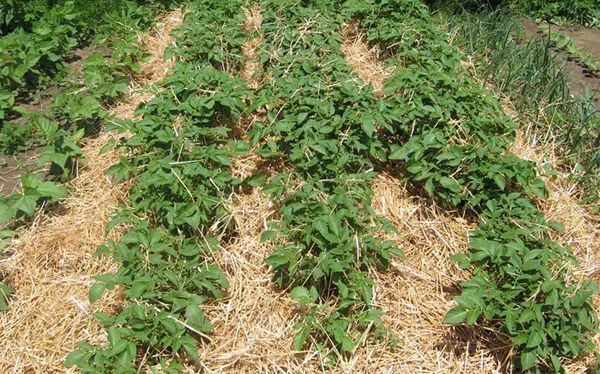
Plant potatoes this method is advisable on heavy virgin lands. Digging the soil in this case is not necessary, even weed grass can not break through a layer of straw. In this way, it is easy to get rid of it.
Description:
- The landing site is plowed with a tractor, harrowed with a cultivator. If there is no technique, weed is cut manually.
- Seed tubers are laid out in the usual way 50x50 cm.
- The surface is completely covered with 10 cm straw.
- Mineral fertilizers are scattered on top, the rotted manure is laid out.
- Again cover the area with straw 5 cm.
- As the tops grow, more straw is added.
Pros:
- physical efforts are reduced to a minimum: there is no need to dig up the soil, to spud and to remove weeds;
- easy to harvest;
- new tubers are large without adhering dirt.
Minuses:
- it will take a lot of straw, you need to think in advance where to get it;
- mice can be found in dry grass;
- with sustained drought, frequent watering will be required.
A similar agricultural technique of growing potatoes in the grass helps to destroy weeds on the site in one season. After harvesting, the straw is closed into the ground. This will improve the structure of the soil, loosen it, fertilize.
In barrels or bags
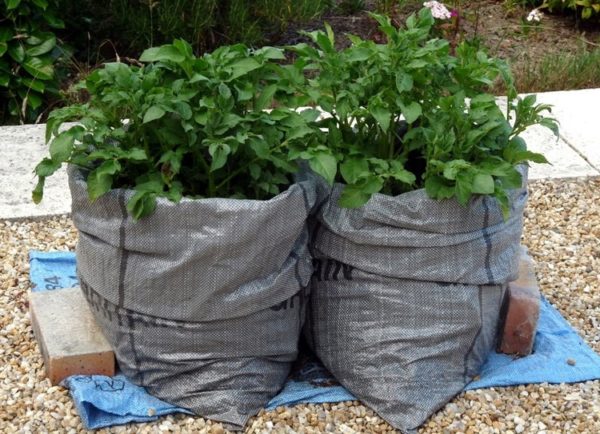
This method of planting potatoes is used in summer cottages where there is little space. The container can be placed on any suitable site.During unexpected cooling, barrels or bags are brought into greenhouses or other insulated rooms (sheds).
Description:
- Bags and barrels are filled with 1/3 of fertilized soil or compost.
- In each container put 2 root tubers, sprinkle with a substrate.
- It is watered with a small amount of water, hermetically closed, leaving a “air cushion” 10-15 cm high on top.
- After the first shoots appear, the bags are opened, and compost and fertilizers are added a little.
The advantages of this method are obvious:
- ideal conditions for growing early potatoes are created;
- plantings are easy to care for, harvesting does not create special problems;
- varietal potatoes can be propagated quickly and without loss.
There is one small drawback - you need to collect the right amount of bags, buckets or barrels. If desired, this problem can be solved by collecting used bags of sugar, flour. A few old buckets and barrels will complement the container shortage.
In the mounds
The method of planting potatoes on the barrows is used for growing and propagating valuable varieties of root crops. Agricultural cultivation requires some effort when planting and caring for plants. Potatoes in high beds are growing fast, but required constant watering.
Description:
- Choose an even square or round piece of land measuring 150x150 cm, or with a diameter of about 2 meters.
- They dig the soil, make fertilizers, dig holes along the perimeter of the mound at a distance of 30 cm from each other, lay out the seeds in them and sprinkle with earth.
- As the tops grow, the lateral stems during earthing spread out over the ridge, leaving the tops. Around them they pour earth from the aisles.
- In the center of the mound make a small depression (8-10 cm) for watering
Gardeners almost never use this method because of the difficulties in caring for the plantings. It is ineffective, but sometimes helps growers with the inability to use other methods.
Mitlider method
The cultivation of potatoes by this method is almost no different from the usual method.
| Indicators |
Unit measuring |
Mitlider method | Traditional way |
|
Size of beds: Length Width Between rows |
m cm m |
9 45 0,7 — 1,0
|
Not limited 40-50 0,5 — 0,7 |
|
Mulching |
— | Required | Seldom |
|
Hilling |
— | Not produced | Constantly |
|
Watering |
— | Every 2 days in small doses | Rarely in dry periods |
|
Weed removal |
— | Every 2-3 days | Remove when hilling |
The main advantage of growing potatoes according to the mitlider method - no need to spud potatoes. And also wide aisles are necessarily made, and this already refers to the disadvantages of the method. Summer residents do not always have the opportunity to leave empty areas when other vegetables can be planted on them.
Gulich Method
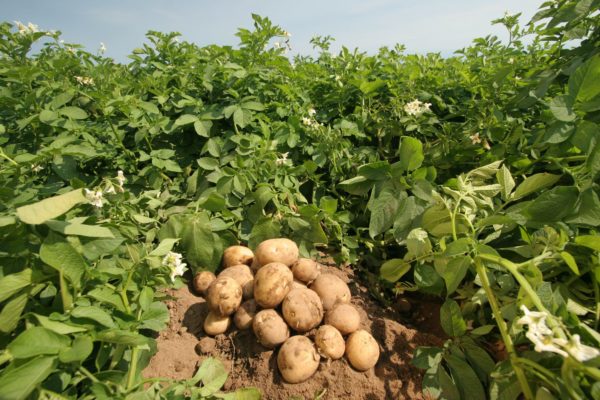
The square-nest landing method is not very popular among summer residents due to the lack of landing space. However, some gardeners use it to quickly propagate elite varieties of potatoes.
Description:
- A plot of land is marked out in squares of 1x1 m.
- Organics (manure, compost) are laid out in the center with a "roller".
- Dig holes up to 10 cm deep.
- Large tubers are planted in pits and covered with soil.
- After the first green shoots appear, they are spread out on their sides, leaving a top of 5 cm high, and the earth is sprinkled on top. As new shoots grow, repeat the procedure several times.
As a result, roots grow on the dug shoots, on which an additional tier of tubers is formed. It turns out a "nest" in several rows (floors). Harvest from one bush increases 2 times. At least 20 root crops are formed.
Seedling seed
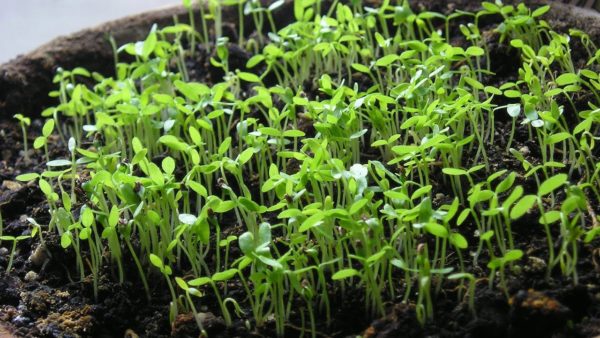
Seed propagation of root crops is carried out in order to preserve and propagate varietal tubers for further cultivation. This long, laborious process does not always justify the effort.
Potato seeds are obtained after the ripening of green fruits. They are collected at a time when the tops turn yellow, and will lie on the ground. The berries are kept in water for 2-3 days, slightly squeezed and squeezed juice with small seeds. Washed and peeled seeds of juice, dried. Store them in dry paper bags for no more than 2 years.
Before planting, dry seeds are soaked in an aqueous solution of growth stimulants for 5-7 days. After the appearance of sprouts, they are planted in a prepared substrate. Seedling care is no different from growing other nightshade crops.
In early May, seedlings are planted in open ground or in greenhouses. Full-fledged, ready-made tubers are harvested in the fall. Only next spring they are planted to obtain a harvest of marketable potatoes.
Potatoes: how to grow in a greenhouse
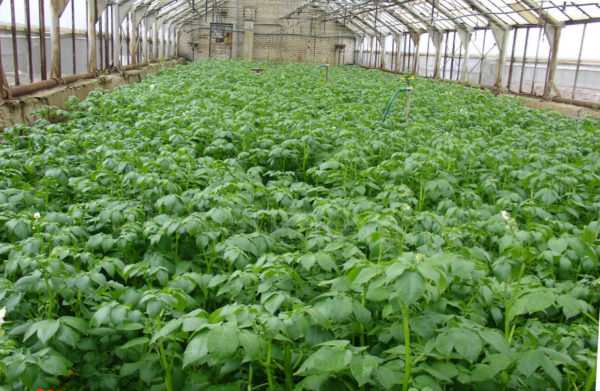
Growing potatoes in a greenhouse in summer cottages is an expensive and time-consuming task, so gardeners prefer planting seedlings in open ground. They set aside a small area in heated greenhouses to harvest young potatoes in the winter.
Tubers are planted at the end of September to get a harvest for the New Year. To grow new potatoes in May-June, the second planting is carried out at the end of March. The technology of this method is identical to conventional methods and depends on the selected method.
Under the film
The use of black film or non-woven material is effective for planting early potatoes in regions with short and cool summers. In the Urals, in Siberia, even in the Moscow region, such a method is successfully used.
Description:
- The land on the potato plot is prepared in the fall or 1-2 months before planting. They dig up the whole territory, make fertilizers, and close it with a film.
- Do the marking of rows and holes. In the marked places, the material is cut crosswise, the ends are bent up, and the earth is raked out.
- A root crop is placed in the holes, sprinkled with excavated earth.
- Watering and top dressing are combined, solutions are introduced into the holes made.
Under the film, the natural microclimate is preserved for a long time, which helps to increase the yield by 15-25 percent.
The only drawback is the high cost of covering material, but it is also covered by the absence of labor-intensive processes of hilling and weeding.
The main stages of growing potatoes
The use of different methods and techniques is based on the implementation of the main works that are the same for all technologies with rare exceptions. In summer cottages and in private households, these works are carried out manually or with the help of small-scale mechanization.
| Events | Description of work |
|
Soil preparation |
In autumn or early spring, the site is dug up. Mineral fertilizers are introduced at the end of September, organic matter - in May next spring |
|
Preparing planting material |
One month before planting, seed tubers are taken out of storage and placed in a warm place for germination. They are planted when the length of the processes becomes no more than 1-2 cm |
|
Watering |
In central Russia, potato plantations are rarely watered. Natural precipitation in the form of rain falls quite often, their moisture is enough for the normal growth of root crops. With a steady drought, potatoes are watered 1-2 times in 10 days |
|
Top dressing |
Fertilizers made in autumn and spring during planting satisfy the need of potatoes for nutrients until the end of flowering. In the future, potatoes are fed 1-3 times before harvesting. |
|
Weeding, cultivating and hilling |
During the growing season, plantings are weeded, loosened or spud (if required by the cultivation technique) several times. The first - with the growth of tops at 10-15 cm in height, the last - after the ripening of fruit-berries |
When planting and growing potatoes, certain conditions and rules must be observed in order to ensure normal plant growth and achieve a good harvest.
| The necessary conditions | Possible consequences of non-compliance with the rules | Recommendations |
|
Good site lighting |
Slowed growth, loss of leaf brightness, decreased yield |
Plant potatoes in open, well-lit areas. Avoid shading by trees and bushes |
|
Optimum air temperature in the range from 12 to 24 degrees |
With an increase or decrease in temperature standards, plant roots slow down growth, with frosts up to 1-2 ° the tops die |
Plant root crops after the onset of stable warming in late May, early June |
|
Humidity of air and soil not lower than 70-75% |
Decrease in a crop to 30%, decrease in the size of root crops |
Arrange on-site timely irrigation in dry weather |
|
Good soil aeration |
Deterioration of the presentation of tubers, decreased taste |
Improve the structure of heavy soils by introducing loosening substances: compost, manure, sand and peat. Such land must be constantly loosened, break the top crust after rain |
|
Soil enrichment with microelements |
With a lack of nitrogen, potassium, phosphorus and other necessary substances in the soil, the bushes become stained. They are affected by fungal diseases. |
Determine the composition of the soil and the lack of substances that are necessary for the normal vegetation of potatoes. Feed the plants with those microelements that are not enough |
Protection against diseases and pests
Carrying out preventive measures in autumn and spring helps to protect potato plantings from the appearance of fungal diseases and the invasion of harmful insects. For such protection, there are various means: organic (folk recipes) and chemical preparations.
The Colorado potato beetle and other insects are destroyed using decoctions, infusions from plant components. They also use more effective chemicals: Commander, Lightning, Spark, Aktara, Sonnet.
Fitosporin, Revus, HOM will protect potato plantations from fungal and infectious diseases. Potent drugs are used to combat established diseases. You can use them no more than 1-2 times for the entire growing season.
Harvesting and storage
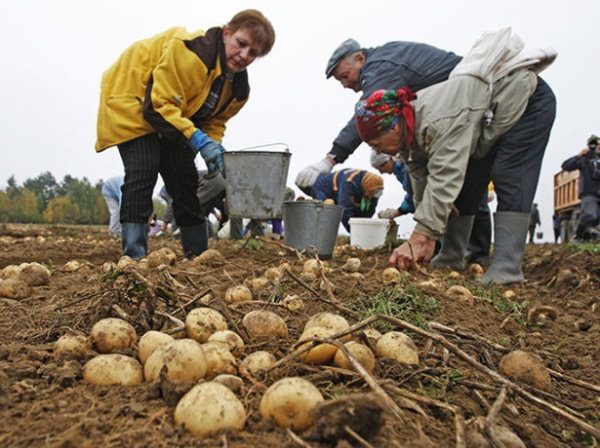
The best time in potato growing is harvesting. Depending on the weather, it starts in late August and ends in October. In large agricultural companies, on the production fields, potato harvesting machines are operating at this time. Summer residents also dig potatoes manually with a trench tool. Few gardeners can afford the purchase of small-sized “cleaners” because of their high prices.
However, homegrown craftsmen are able to assemble such a machine from a walk-behind tractor and improvised means. With its help, the hard work of harvesting potatoes is not terrible, and the time for it is reduced by 2-4 times.
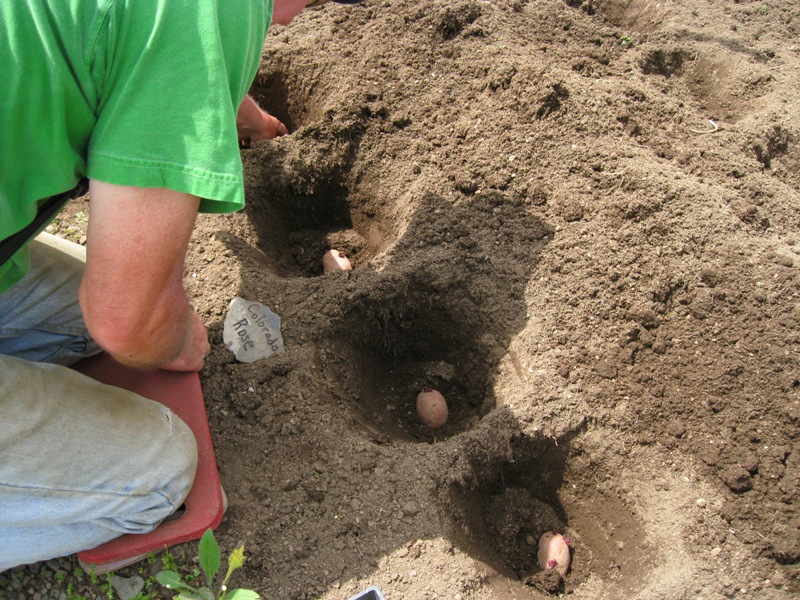 You may be interested in:
You may be interested in:After harvesting, the potatoes are sorted and stored for storage in cellars, cellars, insulated sheds or barns.Tubers intended for spring planting are dried in the shade, stacked in boxes with holes for aeration. Potatoes will be stored until next spring or until a new crop, subject to storage rules.
New methods of growing potatoes are not suitable for all cases, but some of them gardeners have mastered and appreciated their benefits. In summer cottages, potatoes occupy small areas; planting and caring for their plantings is not difficult for gardeners. If to use means of mechanization, labor costs and time are reduced. Such work brings satisfaction and pleases with high yields of hardworking gardeners.




 Description and description of varieties in Belarus with a photo
Description and description of varieties in Belarus with a photo Do I need to pick flowers from potatoes: why do they do it
Do I need to pick flowers from potatoes: why do they do it When to dig potatoes: timing and availability of new potatoes
When to dig potatoes: timing and availability of new potatoes How to grow a good potato crop: various methods and methods, planting and care
How to grow a good potato crop: various methods and methods, planting and care